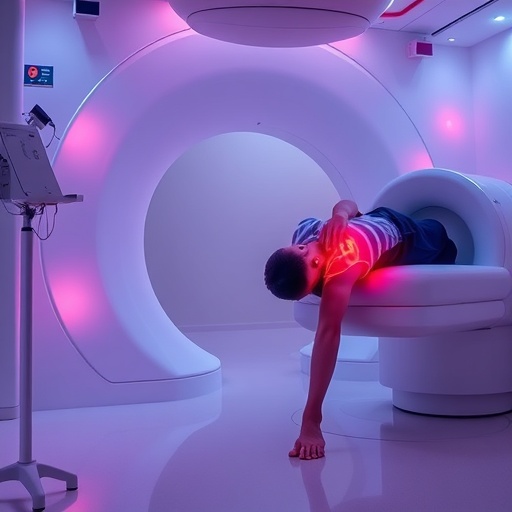Emerging clinical evidence now suggests that a single course of low-dose radiation therapy may revolutionize treatment paradigms for individuals afflicted with mild to moderate knee osteoarthritis, a debilitating condition that affects millions globally. A pioneering randomized, placebo-controlled trial conducted in South Korea has demonstrated that administering radiation at doses significantly lower than those used in cancer treatment significantly alleviates pain and enhances joint function over a four-month follow-up period. This breakthrough research, which mitigates the confounding placebo effects notoriously prevalent in osteoarthritis trials, heralds a potential paradigm shift in the management of this chronic disease.
Osteoarthritis, characterized by the progressive degradation of articular cartilage, poses a major clinical challenge, as its symptoms lead to chronic pain, stiffness, and impaired mobility. Traditionally, therapeutic strategies have revolved around a spectrum ranging from conservative pain management with acetaminophen and nonsteroidal anti-inflammatory drugs (NSAIDs) to invasive joint replacement surgeries. However, existing pharmacologic treatments often carry significant side effects, while surgical interventions are reserved for advanced stages and involve substantial risks and recovery. There exists a conspicuous therapeutic void for moderate interventions that can bridge these extremes, underscoring the urgent need for alternative modalities.
Low-dose radiation therapy, although extensively employed to palliate joint pain in European countries such as Germany and Spain, has been met with skepticism and limited utilization elsewhere predominantly due to misconceptions about the inherent risks of radiation exposure. This new clinical trial challenges these misconceptions by deploying doses less than 5% of those typically administered in oncological contexts, specifically targeting affected knee joints away from vital organs to minimize collateral damage. Remarkably, no radiation-related adverse effects were reported over the study duration, highlighting a compelling safety profile.
The trial enrolled 114 patients diagnosed with mild to moderate knee osteoarthritis from three academic institutions in Korea. Participants were randomized to receive either a very low dose (0.3 Gy), a low dose (3 Gy) radiation regimen, or sham treatment, where procedural simulation mimicked radiation delivery absent of actual exposure. Each subject underwent six treatment sessions, maintaining rigorous blinding to ensure unbiased outcome assessment. Additionally, participants were restricted from using potent analgesics, permitted only acetaminophen as needed, thereby avoiding confounding analgesic effects during the evaluation period.
Efficacy endpoints were assessed using validated international criteria that classify responders as individuals exhibiting meaningful relief in at least two of three domains: pain, physical function, and overall clinical impression. The low-dose cohort manifested a 70% responder rate, a statistically significant improvement compared to the 42% observed in the sham group (p=0.014), thus affirming the therapeutic benefit beyond placebo effects. In contrast, the 0.3 Gy arm did not demonstrate clinically significant divergence from controls, suggesting a dose-dependent mechanism of action.
Further analysis revealed that composite improvements encompassing pain, stiffness, and functional ability were more frequently reported in the 3 Gy group (56.8%) relative to the placebo recipients (30.6%, p=0.024). Interestingly, secondary endpoints such as reduction in analgesic consumption and other symptomatic indices did not display marked differences, warranting continued investigation into long-term and mechanistic nuances. These findings emphasize that low-dose radiation primarily exerts its effect through modulation of symptomatic manifestations rather than immediate opioid-sparing benefits.
This study’s rigorous sham-controlled design represents a methodological advancement, distinguishing it from previous trials wherein concomitant use of NSAIDs and opioids obscured the clarity of radiation’s intrinsic efficacy. By limiting analgesic use and incorporating a placebo arm that underwent identical procedural conditions, this trial provides compelling evidence delineating the genuine clinical benefit attributable to the irradiative intervention itself. The high placebo responder rate, around 40%, closely aligns with historical data from diverse osteoarthritis studies, reinforcing the necessity of placebo controls in validating new treatments.
From a biological perspective, low-dose radiation is posited to exert anti-inflammatory effects via modulation of the synovial microenvironment and alleviation of inflammatory mediators, which are implicated in osteoarthritic pathophysiology. While radiation cannot regenerate obliterated cartilage or physically restore severely damaged joints, it may modify disease progression and symptomatology in cases where joint structures remain relatively intact. This supports the utility of radiation as a disease-modifying adjunct for those with less advanced osteoarthritis, potentially postponing or even obviating the need for joint arthroplasty.
Importantly, the integration of low-dose radiation therapy should be conceptualized as part of a comprehensive treatment algorithm encompassing established strategies such as weight management, physical rehabilitation, and pharmacotherapy. Synergistic application with these modalities may potentiate therapeutic outcomes and improve patient satisfaction, addressing the multifactorial nature of osteoarthritis management. Patient-centered decision-making is paramount to balance the benefits and limitations of emerging treatments within individualized care plans.
Ongoing investigations will extend follow-up to 12 months to elucidate the durability of symptom relief and correlate clinical improvements with imaging biomarkers indicative of joint health. Larger pragmatic trials are also envisaged to stratify patient populations most likely to benefit and to undertake cost-effectiveness analyses comparing radiation therapy with intra-articular injections and pharmacological regimens. Such data will critically inform clinical guidelines and health policy, facilitating broader adoption if outcomes remain favorable.
As the global burden of osteoarthritis escalates in tandem with aging populations, innovative and safe therapeutic options are imperative. This Korean trial illuminates a promising avenue leveraging low-dose radiation therapy to improve quality of life for millions affected by knee osteoarthritis. By dispelling entrenched misconceptions about radiation and substantiating efficacy through rigorous scientific methodology, this research may catalyze a new era in musculoskeletal disease management.
The American Society for Radiation Oncology’s annual meeting provided the platform for unveiling these transformative results, underscoring the interdisciplinary potential of radiation oncology beyond cancer treatment. Continued research and collaborative efforts will determine the ultimate clinical role of this modality. Meanwhile, clinicians and patients alike may anticipate an expansion of therapeutic horizons tailored to the nuanced needs of osteoarthritis sufferers worldwide.
Subject of Research: Clinical effectiveness of low-dose radiation therapy in knee osteoarthritis
Article Title: Clinical Effectiveness of a Single Course of Low-Dose Radiation Therapy in Knee Osteoarthritis: Evidences from a Randomized, Sham-Controlled Trial
News Publication Date: September 28, 2025
Web References:
American Society for Radiation Oncology (ASTRO) Annual Meeting: http://www.astro.org/annualmeeting
Abstract LBA 06: https://amportal.astro.org/sessions/ct-01-21645/clinical-effectiveness-of-single-course-low-dose-radiation-therapy-in-knee-osteoarthritis-sho-109482
Study Presentation & Virtual Meeting: https://amportal.astro.org/sessions/ct-01-21645
Researcher Bio: https://amportal.astro.org/byoung-hyuck-kim-md-phd-135180395
Keywords: Osteoarthritis, Knee osteoarthritis, Low-dose radiation therapy, Randomized controlled trial, Placebo-controlled study, Joint pain management, Anti-inflammatory therapy, Radiation oncology, Therapeutic radiation, Clinical trial, Musculoskeletal disease, Pain relief.





